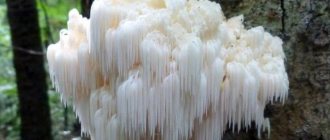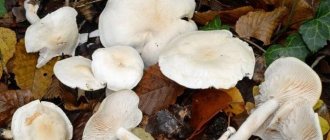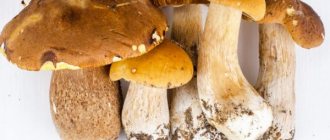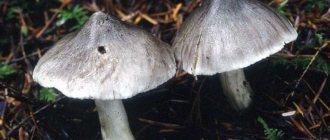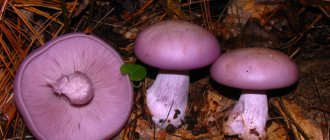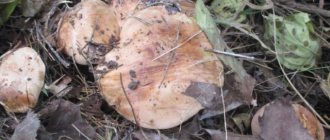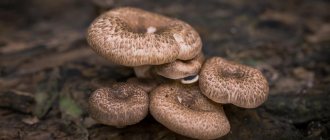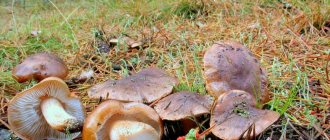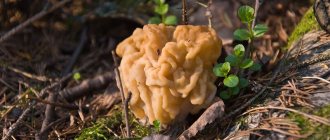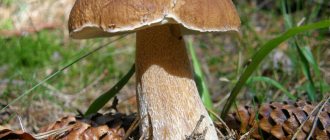There are about 2,500 species of row mushrooms, forming a large family that includes edible, conditionally edible, inedible and poisonous mushrooms. These fruiting bodies grow in mixed or coniferous forests, preferring sandy soils or loam. The peak of mushroom picking occurs at the end of August and continues until mid-October. Usually the smell of edible rows is pleasant and delicate, reminiscent of perfume. You can prepare any dish from them, as well as prepare them for the winter: pickle, fry or salt.
Description of Ryadovka Belaya
This mushroom is also called the “white knight”. It belongs to the family and genus Oryadovaceae. It got its name for a reason: it usually grows in certain heaped rows.
From Latin - Tricholoma album.
hat
The size of the white cap varies from 6 to 10 cm. The color ranges from pure white to milky. Its top is grey-white. The skin of the cap is dry to the touch. Old mushrooms develop a light yellow spot interspersed in the center of the cap.
In a young specimen, the shape of the cap is convex, the edges are slightly turned up. As they grow older, the surface of the cap gradually straightens.
Pulp
The mushroom is endowed with dense white pulp. When broken, it acquires a pinkish tint. Young specimens have no smell, but as they grow they develop an unpleasant aroma that is a bit like the smell of radish.
The lower part of the cap is called the hymenophore. It consists of white, frequent and rather wide plates that have different lengths. They descend slightly along the leg. In early age specimens the plates are painted white. In adult mushrooms they gradually turn yellow. The spores are beige in color.
Leg
If we talk about the stem, it has a rather dense structure and is identical in color to the cap. As it grows, the stem turns light brown at the junction with the cap. The length of the leg is usually 10 cm, but most often it measures 7–8 cm.
Usually the leg is velvety, but in some cases it is fibrous, scaly and glabrous.
Similar species
When harvesting mushrooms, you need to be able to distinguish between edible and inedible ones. The white row strongly resembles champignons, but can be recognized by the following characteristics:
- acrid taste and too rich pungent odor;
- light plates that do not darken.
Among the large number of rows, there are both edible and unsuitable species. Many of them are very similar to the white row, but still distinctive features exist.
Similar species:
- The row is gigantic. This variety is suitable for consumption. The mushroom is endowed with a smooth yellow-brown cap, the diameter of which can be about 20 cm. The stem is round, large, thickened below. The length can reach up to 10 cm, and the maximum thickness can be up to 6 cm. This mushroom has dense and white flesh, which, when cut, changes color to cream or reddish. The aroma is very pleasant, mushroom. The taste is slightly bitter and has a faint walnut flavor.
- The row is pseudo-white. This is an inedible variety of mushroom. Grows from early August to October alone or in small quantities. Pseudowhite can be found in deciduous and mixed forests. The size of the cap varies from 3 to 8 cm. At an early stage of development, the cap is hemispherical, but then simply transforms into a convex one. It has a white or soft pink tone. The length of the leg reaches 9 cm, the diameter is 1.5 cm. The pulp in young specimens is whitish, in mature ones it is yellowish. Has a powdery smell.
- Earthy. An edible variety, but it is very easy to confuse it with its inedible and poisonous counterparts. This mushroom is slightly smaller in size. The diameter of the cap usually does not exceed 9 cm, and the average size is about 6 cm. The shape is cone-shaped or hemispherical, the skin is formed by small scales. The color of the cap is grayish and may have a brown tint. The leg is cylindrical, white, and becomes hollow over time. Its length is 5–9 cm, and its girth is up to 2 cm. When cut, the smell of the mushroom is similar to laundry soap. Taste and smell are little expressed. The pulp does not change color when cut.
- Gray. The cap of the mushroom grows up to 12 cm. In young mushrooms, its shape is strongly convex and curled. As it grows, it gradually becomes flat and cracks form on the skin. The leg is high, can grow up to 15 cm. The plates are located loosely relative to each other. Later they turn light yellow or grayish. The variety is classified as edible mushrooms. The variety is often found in coniferous forests.
- Tiger. This is a poisonous mushroom that causes severe poisoning of the body. The main danger and insidiousness lies in the fact that it is tasty, which gives the impression that it is edible. The size of the cap can reach up to 12 cm. Initially, its shape is spherical, but then it becomes bell-like. In adult mushrooms its surface is flat. The color is dark gray to black, whitish or light gray. The skin of the cap is scaly with a tiger pattern. The length of the leg sometimes reaches 15 cm. This species lives in different forests. It grows both in large groups and singly. The tiger is considered a rare species.
The smell of mushrooms from a chemical point of view or Why mushrooms smell
The smell of mushrooms is very difficult to translate into chemical formulas. It is not just any individual molecules that are responsible for the aroma of a mushroom, but mixtures of substances with different concentrations. Even if characteristic compounds are found in some types of mushrooms, this does not give us final confidence that they are the problem. For example, norisoprenoids are found in various types of buttermilk: trans-geranylacetone and (E,E)farnesylacetone, but whether these compounds really characterize the aroma of buttermilk is not known. The aroma of fresh chanterelles, according to many, is reminiscent of apricot. True, the lists of characteristic aromatic compounds of chanterelles and apricots almost do not overlap; they only have 1-octen-3-ol and hexanal in common, but neither of them smells like fruit. The terpenoids dihydroactinidiolide and limonene are responsible for the fruity smell of chanterelles, while benzaldehyde (almond aroma) and phenylacetaldehyde (honey pink) are responsible for the floral notes. Apparently, the combination of these substances gives chanterelles their apricot note. The porcini mushroom with its unique aroma is rightfully considered the king of mushrooms. The broth made from whites also has a special taste. In addition, the aromas of porcini mushrooms tend to intensify during drying and storage: after six months, the concentration of aromatic compounds in dried mushrooms increases sharply, tens of times for furans and pyrazines. Another sign of the aroma of dried mushrooms is the high concentration of methional. The smell of fresh mushroom is dominated by the same aliphatic alcohols and ketones that are responsible for the general mushroom taste. But during cooking and especially during drying, a number of reaction products are formed between amino acids and sugars: a mixture of pyrazines (methylpyrazine, 2,5-dimethylpyrazine), furans (furfural, 5-methyl-2-formylfuran), pyrroles and thiazoles. All of these compounds are characterized in one way or another by a roasted or brothy aroma, which, together with a common mushroom note (1-octen-3-ol and 1-octen-3-one), gives dried whites their unique smell. Sometimes mushrooms smell similar to cooked meat, and this is no coincidence. For example, 2-methyl-3-furanthiol is a characteristic component of meat odor.
The most famous mushrooms that do not grow in the wild in Russia are perhaps truffles and shiitake mushrooms. There are quite a few types of truffles, but two are considered the most noble and aromatically interesting - black and white truffles. Actually, the smell of mushrooms is their main value, and it is not surprising that the aromas of truffles are the best studied. Among the many myths surrounding truffles, there is one chemical one. For some time it was believed that the unique smell of truffle mushrooms was caused by androstenol, which was discovered through chemical analysis. Indeed, the temptation to make a mistake was great, because androstenol is the pheromone of boars, which have always been used to search for these mushrooms. However, further studies showed that the main contribution to the smell of mushrooms comes from simple sulfur-containing compounds. For black truffles, these are primarily dimethyl sulfide and dimethyl disulfide, and for white truffles, bis-(methylthio)-methane. In fact, it is by the smell of dimethyl sulfide that pigs and dogs find the mushroom. This compound itself smells like boiled cabbage and seaweed, so it’s not surprising that not everyone loves truffles.
Shiitake mushroom is cultivated as widely as champignons, and with the advent of oriental restaurants, it is no longer exotic for us. Shiitake has a unique aroma that develops when dried. It is caused by a rather unusual chemical called lenthionine. It is not present in fresh mushrooms, but when the cell walls are damaged (especially during drying), not only lenthionine is formed, but also related aromatic components.
Let's summarize some results. Mushrooms are a special group of living organisms: at the biochemical level they are similar to both plants and animals. For example, the components of the cell walls of fungi, chitin and chitosan, are related to fungi with insects and crustaceans, and our body does not absorb these compounds. On the other hand, mushrooms are rich in amino acids, including essential ones. But the main, almost intangible value is the magnificent aromas: porcini mushroom broth, crispy saffron milk caps, white truffle. I wonder if this autumn will be a mushroom one?
First aid for poisoning
A person may confuse an edible variety with a poisonous one. In this case, poisoning occurs a few hours after eating the mushrooms. The following symptoms appear:
- general weakness;
- heavy salivation;
- nausea and vomiting;
- pain in the stomach;
- diarrhea.
First aid for mushroom poisoning:
- Call an ambulance immediately.
- Provide plenty of fluids and bed rest.
- Give the victim activated charcoal or another drug that has an identical effect.
- Rinse the stomach lightly with a pink solution of manganese.
You cannot take measures on your own and treat yourself at your own discretion in case of mushroom poisoning. If you have the symptoms described above, you should immediately consult a doctor. If not treated in a timely manner, intoxication quickly leads to serious consequences.
Deadly poisonous
There are about 30 highly toxic mushrooms in the forests of our country. Let's name some of them.
- Death cap. The most dangerous of all, because... similar to russula and forest champignon. It can be found from August to September in deciduous or mixed forests. It has a smooth gray cap of white color, a narrow stem with a thickening at the base. The poison of the toadstool is very strong and is preserved even during heat treatment and drying. It is enough to eat 100 g to become poisoned. Signs of poisoning do not appear immediately, but within 2 days.
- Panther fly agaric. It can be found in coniferous and deciduous forests from July to October. It has a brown cap, which can sometimes be gray or brown. There are a lot of white flakes on it. The leg is thin, thickening closer to the base. It is almost impossible to survive after eating this mushroom. 2 hours after it was eaten, the victim begins to suffer from suffocation and severe convulsions, and he loses consciousness.
Often confused with these mushrooms
The white row is also similar to other mushrooms of the same color and shape. Because of this, it can be confused.
Champignon
White row mushrooms are often confused with field champignons, since at first glance they are very similar to each other. But upon closer inspection, you can notice the differences. First of all, this relates to smell. In the row, it has a very different aroma from the champignon aroma.
In champignons, the path plates darken and turn brown, but in rows this does not happen. Another difference is that champignons have a skirt that encircles the leg. The inedible mushroom does not have it.
Pigeon row
This subspecies is usually found in autumn. It is completely safe for use in cooking. Main differences:
- can grow not only in groups, but also individually;
- the flesh is dense and fleshy;
- has a pleasant subtle aroma;
- the scales almost completely cover the cap.
This mushroom is widely used in a variety of dishes. Suitable for frying, boiling and other cooking methods.
White milk mushroom
Although the white milk mushroom looks similar to the white milk mushroom, these varieties are very different. The main difference is the shape of the cap. In milk mushrooms it is funnel-shaped (with a concavity in the center).
Among other differences, one can easily distinguish the presence of waviness along the rim of the cap, as well as a denser and juicier structure of the pulp. The leg of the milk mushroom is much shorter than that of the white milk mushroom.
Taste qualities of rows
In terms of taste, edible and conditionally edible rows are practically no different from other mushrooms that can be eaten. However, many mushroom pickers, especially beginners, are afraid to collect them, because all rows have an interesting bright or pale color, which is characteristic of some false doubles and even toadstools. That is why it is very important to be able to distinguish between edible types of rows.
Don’t forget the main rule of a mushroom picker: “If you’re not sure, don’t take it!” . Collect only those types of mushrooms that you are sure of. And if there is even the slightest doubt, it is better to abandon the idea of putting mushrooms in a basket. In addition, the smell of the rows speaks volumes: if it is unpleasant, has a powdery or dusty aroma, the mushroom is poisonous.
